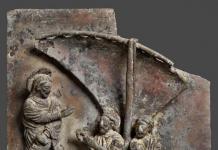Almost every item has several types and purposes, including stoves. There are stoves for heating rooms and for cooking food, and there are special devices for melting metals or storing them in molten form. Such devices are called crucible melting furnaces. They have a specific purpose and therefore the list of enterprises where they have found their application is quite small. These are mainly factories and laboratories. But what to do if you need to melt metal for some purpose at home? Buying such equipment is very expensive, but it is quite possible to make it yourself. This requires minimal knowledge in this area, desire and time.
Types of crucibles
 A crucible furnace is a container made of refractory material in which, when heated to certain temperature, melt metal. The main materials from which crucibles are made:
A crucible furnace is a container made of refractory material in which, when heated to certain temperature, melt metal. The main materials from which crucibles are made:
- ceramics;
- graphite;
- cast iron.
Used crucible furnaces like in factories where more are produced hardware, and in small enterprises, for example, for the manufacture of jewelry.
Ceramic ovens- This best option. When metals are melted in a ceramic crucible, no changes occur in the substance itself. Therefore, in such crucibles there are no problems Even base metals or alloys can be melted from cobalt, chromium or palladium.
Graphite crucibles. These ovens are different for a long time operation and high resistance to oxidation, which makes them universal for melting any metals and especially alloys based on zinc and brass. In addition, they are often used in induction furnaces. Graphite crucibles can withstand very high temperatures, such as eight hundred degrees to melt aluminum.
Cast iron crucibles are perhaps the worst of the three listed. They have high reactivity, rapid oxidation and interaction with other metals, and cast iron does not resist high temperatures well. For these reasons cast iron crucibles are very rare, but they are inexpensive and quite accessible.
This article will look at methods for making three types of homemade crucibles.
Crucible furnaces
















Inductor assembly
 The heating element of the crucible arm at home is usually an inductor. He has cylindrical shape with a cavity inside. A homemade crucible with metal shavings is placed in this cavity. Inductor made of fireproof material, inside it is a winding of wire, most often copper wire is used. Using a special generator, current is supplied to this winding, which creates an electromagnetic field. Which, in turn, creates an eddy current in the crucible and in the metal placed in it. They melt the chips. The inductor itself is assembled from 4 vacuum tubes with a parallel connection. Such an inductor can be connected to a regular outlet.
The heating element of the crucible arm at home is usually an inductor. He has cylindrical shape with a cavity inside. A homemade crucible with metal shavings is placed in this cavity. Inductor made of fireproof material, inside it is a winding of wire, most often copper wire is used. Using a special generator, current is supplied to this winding, which creates an electromagnetic field. Which, in turn, creates an eddy current in the crucible and in the metal placed in it. They melt the chips. The inductor itself is assembled from 4 vacuum tubes with a parallel connection. Such an inductor can be connected to a regular outlet.
There is another option for assembling an inductor with your own hands from an electromagnetic core and two layers of winding. First layer – 10 turns copper wire with a thickness of 4 mm, and the second is one turn, the material for which is a metal plate with a cross-section of 15 * 5 millimeters. The electromagnetic core has U-shape and is a set of steel plates. The first winding is made around the plates, which is placed in an insulated housing, the secondary winding connects the core and metal bars, between which there should be a distance equal to the dimensions of the crucible. This entire structure is placed in the furnace body.
So, we get a furnace in which the inductor is located. Wires go from the inductor to the socket. A crucible is placed in this furnace in such a way as to enclose the bars. If it is placed correctly, a buzzing sound will be heard, indicating that tension has appeared and melting has begun. If there is no sound, then use the handle to move the crucible until the circuit is completely closed.
Assembling a cast iron crucible
A metal casing is taken and a glass made of cast iron is placed in it. A mixture of sand and clay is poured between them. A handle is attached to the side. After one or two heatings, the mixture will melt and harden. The crucible is ready. Chips are poured into it and placed in the inductor.
Making a crucible from clay
 You can make a crucible from fireclay clay. This inexpensive option and also highly resistant to high temperatures. like this clay is used for laying stoves and it can be bought at any hardware store. Fireclay clay can withstand temperatures up to 1600 degrees Celsius.
You can make a crucible from fireclay clay. This inexpensive option and also highly resistant to high temperatures. like this clay is used for laying stoves and it can be bought at any hardware store. Fireclay clay can withstand temperatures up to 1600 degrees Celsius.
So, you will need fireclay clay (sold in bags in construction stores), liquid glass (sold there) and ground fireclay. It can be purchased or made from fireclay bricks.
In order to make a mixture from which a crucible will be fashioned in the future, take 7 parts of clay, 3 parts of fireclay and 10 tablespoons of liquid glass per liter of dry mixture. Fireclay and clay are mixed until smooth. After this, water is slowly added. To avoid spoiling the workpiece You can add some of the mixture, and in the case large quantity water - add dry powder. You need to knead until the clay stops sticking to your hands.
Only after the clay of the desired consistency has been mixed can glass be added. When adding glass you need to mix everything thoroughly until the clay stops cracking. It is best to add glass to a lump of clay and roll it into a roll, then fold it several times and repeat the procedure until it stops cracking. The material for the crucible is ready. Until the moment when it is used, it must be stored in several layers of cellophane.
There is clay, now to make a crucible you need to take a mold, the easiest way is to use a plaster mold. How to make such a form can be found on any website on plaster modeling. So, directly making the crucible.
Before you start sculpting, you need to knock all the air out of the clay; to do this, you can lay a newspaper on the floor and forcefully throw a lump on it several times, ten times will be enough. Now take a lump of clay and carefully press it into the bottom of the mold, after which the walls of the product are formed in small lumps. Their thickness can be controlled along the edge of the mold. Very it is important to carefully press the clay into the mold so that no air cushions form there. After the crucible is sculpted, you need to make the inner surface smooth. To do this, just moisten the clay with water.
After this comes the moment of drying. A mold with clay is placed cardboard box and cover with a lid. After seven hours, all the water from the clay will evaporate and the shape of the future crucible will “shrink” a little, so getting it out of the mold is not particularly difficult. After this, the crucible continues to dry in the same box; as it dries, all defects will be eliminated by themselves and the pot will acquire a gray color. Sometimes small cracks may appear. They can be covered with wet clay. Next, the pots are fired at a temperature of 800 degrees muffle furnace. After firing, the crucible is ready for use.
Graphite crucible
Graphite is a material that has many unique properties. Positive qualities graphite:
- resistance to molten metals;
- increase in strength with increasing temperature;
- high heat resistance and thermal conductivity;
- small specific gravity.
To make a crucible from this material you will need:
- graphite powder;
- solid graphite;
- felt;
- graphite tube;
- fireclay mortar;
- magnesite.

Some of these materials can be used as independent units. For example, a graphite tube is essentially already a crucible; you just need to make a bottom in it.
The principle of manufacturing from all materials is the same. Let's look at the example of mortar. Two forms are made. You can roll it out of thick paper to make it easier to remove later. External the shape has the configuration of a hollow cylinder, and the inner one is just a cylinder. The small cylinder is inserted into the wider one. The mixture will be poured between them. The mold is placed in a plastic cup and mortar powder is poured into it. You need to fall asleep with a slide, as it will sit down when you need to compact it. 15 cubes of liquid glass are poured into this powder using a syringe. Everything is mixed and the consistency of shortcrust pastry is obtained. Stuff into the mold in small portions.
The result is something like a glass turned upside down. To prevent the form from sticking to the table, it is best to do the entire procedure on cellophane. Then the mold is turned upside down and the inner cylinder is removed. It is also best to initially glue it with cellophane or tape. Then, when removing, the shape of the crucible will not be damaged.
After the crucible has dried, it must be placed in the inductor and heated. This is necessary do at low temperatures, since all the water should evaporate, despite the fact that outwardly it seems as if it is not there at all. If the crucible is not preheated and you immediately start melting in it, it will most likely burst. After warming up, when you tap the crucible, it will make a ringing sound. This indicates that the crucible is well made.
By following the instructions presented, you can quite easily acquire a homemade melting furnace that will last no less than a purchased one. The main thing is to take your time, be careful in your work and not violate manufacturing technologies.
Let's get started:
And so, to make a crucible, you will need: a piece of plastic water pipe As far as I remember, the diameter is approximately 105 mm (outer part of the mold), two wooden disks (bottom of the mold and its lid) made exactly to the size of the inner diameter plastic pipe(you can take plywood, but I recommend a thickness of at least 20 mm), inner part it is shaped like a cone and the bottom is completely rounded (in diameter it should be made not perfectly round, but slightly oval, only 1-2 mm, I will explain why later), three clamps corresponding to the outer diameter of the plastic pipe, three self-tapping screws medium length(depending on the thickness of the wooden circle (future mold lid), two long self-tapping screws(they will be needed in order to pull out the inner mold).
You will also need fireclay clay, fireclay chips made from fireclay bricks (for one crucible with a lid it takes me about half a brick
The pipe must be sawed along its entire length (this will make it easier to remove the finished crucible)
From the side of the future bottom of the mold, we make cuts as in the figure, about 6-10 in total to a depth of approximately 20-25 mm. (they will help firmly secure the bottom of the mold
We install the bottom and secure it with a clamp.
We install the middle clamp, but do not clamp it completely, just so that in the future the walls of the mold do not creep apart, leaving a gap of about 1 mm.
Now you need to cut out 4 paper circles under inner size molds, they will not allow the mixture to stick to the bottom of the mold and to its lid)
Place one of the circles on the bottom of the mold.
Now let's get started with the mixture, it must be mixed very thoroughly. I use a composition consisting of approximately 60% fireclay chips, 30% fireclay clay and 10% charcoal. I mix it first in dry form, then with water; you don’t need much water so that the composition just holds its shape as in the picture.
Further, for savings purposes nervous system During subsequent attempts to remove the crucible from the outer mold, I recommend placing a sheet of paper between the walls of the mold and the mixture. (The first experience of removing the finished crucible from the outer mold took me 2-3 hours and naturally ended in nothing, so I highly recommend using a sheet of paper)
Before forming the bottom of the crucible, it is necessary to measure the distance from the bottom of the mold to its upper edges. As the mixture is compacted, these measurements will need to be repeated until the required bottom thickness is achieved. (Looking ahead, I’ll say that I tried the scheme and vice versa, when the bottom of the crucible is compacted last, and the edges are made first. In principle, this does not matter, in both cases the result depends on how well you compacted the mixture, and are there any voids in it)
After the bottom is ready, we place the inner part of the mold in the center and begin to compact the future walls of the crucible.
It is necessary to compact it very carefully, this is a guarantee that all previous and future work will not be in vain. It is better to add the mixture in small portions.
Let's trample further.
They compacted it. Next we place another cut out paper circle on top.
Closing top cover forms. There should be three holes in it, as in the inner part, through which self-tapping screws will connect the mold lid with its inner, central part.
We wrap the screws. Why three screws? The one in the middle centers the lid, the two side ones are the main ones and the entire load will fall on them.
Now two more large screws.
Next, the most difficult thing is to fix the form horizontally and insert any long object between the large screws (as shown in the figure) and begin to gradually rotate the inner part of the form (for this it was necessary to make it oval). This way the inner part of the crucible expands, which will then allow you to pull out the inner mold.
When it starts to rotate freely, it can be pulled out. Usually the inner walls of the crucible are quite smooth after this.
We remove all the clamps.
We take the crucible out of the mold; usually there are no problems with this.
Inner surface with imperfections at the junction of the bottom and walls that have not yet been puttied.
As for the lid of the crucible, everything is simple here, we secure the bottom in the same shape with a clamp, again put a circle of paper, tamp the mixture and close the lid, having previously placed another sheet of paper on top. Then we press either with a clamp or a hammer. It turns out like this pancake, and when it dries, we drill a hole about 6-8 mm in the center with a drill.
It turns out like this crucible.
Having loaded the contents, cover the outside of the crucible with fireclay clay.
Well, that’s all, all that remains is to put the crucible in the oven.
Now for the most common questions:
What can be melted in this crucible?
I made this crucible for melting damask steel, the melting temperature of iron is 1535 degrees, I did not melt pure iron, it usually holds nails and electrodes, that is, about 1400-1500 degrees. I won’t say how long, but half an hour, an hour - for sure. Naturally, all metals and alloys with a lower melting point can be melted in a crucible.
Try it.
If something goes wrong, experiment with the composition of the mixture.
I haven’t tried to heat it at more than 1500, it doesn’t allow me to bake.
Is it possible to melt copper, brass, bronze, etc.?
Answered in the previous question.
How can you heat the crucible? In what ovens?
I have a homemade coal furnace, I have done more than one melt, and I have never had any problems with the crucible. Again, I repeat, compact the mixture properly, a lot depends on this.
You can also use a propane burner or a furnace using fuel oil (but I haven’t tried it myself), much will depend on the thickness of the walls of the crucible, the thicker it is, the more reliable it is, but it’s also more difficult to heat the contents, more costs energy. Just remember to heat it up gradually; if you heat the crucible only on one side, it will crack any crucible, even a graphite one.
P.S. Well, safety precautions, of course, are not a cup of tea...
To melt metals, special heat-resistant bowls called crucibles are used. They are very popular in jewelry workshops, laboratories and the metallurgical industry.
But for a full-fledged process, it is not enough to acquire a simple object with a heat-resistant surface, because different types of iron require their own product, which must comply chemical composition and be suitable for a specific temperature regime.
Also in these facilities, a finished alloy is produced, which remains to be given the correct shape.
DIY crucible
Sometimes it happens that such devices may be needed in private business, but purchasing them is expensive. Therefore, it is more profitable to make a crucible with your own hands - you can save a significant share of the budget.
Yes, the procedure will require certain skills and patience, but the end result will be a vessel that is not inferior to factory analogues. It is also important to decide on the types of objects to be melted in order to make a suitable bowl.
If you plan to work with different metals, it is recommended to create several products.
Steel crucible DIY crucible for lead
Material selection
Here, fire-resistant components play a serious role, which include:
- Ceramics is an average option, perfect for personal use. There are no reactions that can change the structure of the metal in this cookware, and it is excellent for cobalt, chromium and palladium.
- Clay is a substance that is used in the production of crucibles for jewelers. This component is highly fire-resistant and can withstand up to +1600 °C. If a person wants to create jewelry in own premises, but does not know what to make dishes from for melting, then this option is definitely the best.
- Graphite is excellent for melting galvanized and brass alloys, and its main advantage is durability. Regarding operating temperature, then it should not exceed +800 °C.
- Cast iron. Crucibles made from this substance are rare and belong to the budget categories. Dressings of this kind will also have disadvantages in the form of rapid oxidation, low heat resistance and fast production (up to 30 heats).
Varieties of homemade crucibles
As an alternative, you can use an electric crucible, which you can do yourself without much difficulty. It has several uses, but the main one is gold refining.
General manufacturing steps
To begin with, the raw materials are prepared, and here everything depends on the model of the future tank. It is better to take components with a reserve, because the first thing is unlikely to work out. Also, for safety reasons, production should be carried out away from open fire, and choose a well-ventilated area.
It is safer to carry out work in a garage or special extension.
The second stage is mixing the materials and giving the casting the necessary parameters. For these purposes, plaster molds are used.
Creating the outlines is not difficult, and such information is easy to find on the Internet.
Then a homogeneous material is pasted over the outer part of the model, forming a future homemade refractory crucible. It is also important to give it the required depth and thickness.
Clay crucible in the drying process
And the last step is the drying process: the workpiece is placed in a cardboard box and covered with a lid. This will allow the casting to dry and remove excess water from it.
Sometimes it may be necessary heat treatment However, the most important point is to control the annealing temperature and protect the skin of the hands and face. If the heat is too intense, the item will burst and there is a chance of severe burns.
Detailed instructions on how to make a crucible yourself and at home will be described in the following chapters.
Making a clay crucible
Here you can’t do without fireclay clay, which is sold in any building materials store.
It tolerates extreme thermal effects very well, is cheap, and there are unlikely to be any problems finding it. As a last resort, you can make a crucible from crushed fireclay bricks.
You will also have to buy liquid glass and mix all the ingredients for a homogeneous base. The proportions look something like this:
- 7 units of clay;
- 3 units of fireclay;
- 10 spoons of liquid glass.
Clay crucibles
All components are added in stages: clay and fireclay are mixed until smooth, and water is gradually added to them. The main goal is to create a mixture that will not stick to your hands.
When the required consistency is obtained, glass is added and everything is thoroughly mixed. The main thing here is to bring the object to a state where the plane stops cracking.
The mixture is ready, and for storage it is recommended to use thick cellophane, or wrap it in 7-10 layers of film.
Before sculpting, you will have to remove any remaining air by hitting the substance about 8-12 times on a hard surface.
The mixed material is applied inside the model, its depth and thickness are formed. It is better to create a semicircular bottom, which will give a greater effect during future melting of iron filings. Also, the substance must be pressed tightly against the model so that air does not form between the planes, and for greater convenience it is recommended to wet your hands with water.
Afterwards, the tank is sent for drying: it is placed in a container made of cardboard or plastic and placed in a dry place. A few hours will be enough to remove any remaining moisture. Also, the product will settle a little, and it will be easy to remove it from the mold.
A refractory vessel made of fireclay bricks will last for a long time of use, however, the last point of creation should be the firing procedure in a furnace and at T = 800 °C. And the thing can be used for its intended purpose.
For ease of operation, you will need a crucible furnace, which you can make yourself. For easy installation you can weld a structure of several pipes to form a cylinder. Usually it is fixed on two parallel posts so that it does not touch the ground.
And here the thickness of the walls (minimum 5 mm) and the stability of the product are taken into account (it must easily withstand T = 1600 °C or more).
How to make a graphite crucible
- low overall weight;
- resistance to hot alloys;
- good thermal conductivity;
- strength increases with increasing temperature.
If you take the easy route, you can take graphite rod, and the crucible is almost ready. All that remains is to attach the bottom.
Graphite crucibles in various sizes
If the required tube is not found, everything can be done using two molds different sizes, which are inserted one into one, and the free space will allow you to add required sizes. Initially, you need to pour the mortar into an empty container, and you should not spare it.
The fact is that the powder will compact and settle. Next, add liquid glass (about 15 ml) and mix everything thoroughly.
As a result, a vessel will come out, which is given time to dry. In this case, heat treatment will also be required to remove excess liquid. If all the steps were correct, then you will have a high-quality graphite crucible, made by yourself.
Assembling a cast iron crucible
This type is the worst, but sometimes it brings good benefits. All that is required is to place a cast iron glass of a smaller diameter in a metal bowl, and fill the free space with sand and clay.
DIY cast iron crucible
Next, everything is heated in the oven until the mixture melts and takes on the same type of substance. Afterwards, the cup will harden, and iron can be melted in it. This is basic information on how to make a crucible at home and at minimal cost.
Please select a piece of text and press Ctrl+Enter.
Source: http://StankiExpert.ru/spravochnik/materialovedenie/tigel-svoimi-rukami.html
Melting furnaces: types and design of crucibles, making a crucible with your own hands from graphite, clay or cast iron
Almost every item has several types and purposes, including stoves.
There are stoves for heating rooms and for cooking food, and there are special devices for melting metals or storing them in molten form. Such devices are called crucible melting furnaces.
They have a specific purpose and therefore the list of enterprises where they have found their application is quite small. These are mainly factories and laboratories.
But what to do if you need to melt metal for some purpose at home? Buying such equipment is very expensive, but it is quite possible to make it yourself. This requires minimal knowledge in this area, desire and time.
A crucible furnace is a container made of refractory material in which metal is heated to a certain temperature. The main materials from which crucibles are made:
Crucible furnaces are used both in factories where metal products are manufactured, and in small enterprises, for example, for the manufacture of jewelry.
Ceramic stoves are the best option. When metals are melted in a ceramic crucible, no changes occur in the substance itself. Therefore, in such crucibles there are no problems Even base metals or alloys can be melted from cobalt, chromium or palladium.
Graphite crucibles.
Such furnaces are characterized by a long service life and high resistance to oxidation, which makes them universal for melting any metals and especially alloys based on zinc and brass. In addition, they are often used in induction furnaces. Graphite crucibles can withstand very high temperatures, such as eight hundred degrees to melt aluminum.
Cast iron crucibles are perhaps the worst of the three listed. They have high reactivity, rapid oxidation and interaction with other metals, and cast iron does not resist high temperatures well. For these reasons cast iron crucibles are very rare, but they are inexpensive and quite accessible.
This article will look at methods for making three types of homemade crucibles.
Crucible furnaces
The heating element of the crucible arm at home is usually an inductor. It has a cylindrical shape with a cavity inside. A homemade crucible with metal shavings is placed in this cavity.
Inductor made of fireproof material, inside it is a winding of wire, most often copper wire is used.
Using a special generator, current is supplied to this winding, which creates an electromagnetic field. Which, in turn, creates an eddy current in the crucible and in the metal placed in it. They melt the chips.
The inductor itself is assembled from 4 vacuum tubes with a parallel connection. Such an inductor can be connected to a regular outlet.
There is another option for assembling an inductor with your own hands from an electromagnetic core and two layers of winding. The first layer is 10 turns of copper wire with a thickness of 4 mm, and the second is one turn, the material for which is a metal plate with a cross-section of 15 * 5 millimeters.
The electromagnetic core is U-shaped and consists of a set of steel plates. The first winding is made around the plates, which is placed in an insulated housing, the secondary winding connects the core and metal bars, between which there should be a distance equal to the dimensions of the crucible.
This entire structure is placed in the furnace body.
So, we get a furnace in which the inductor is located. Wires go from the inductor to the socket. A crucible is placed in this furnace in such a way as to enclose the bars.
If it is placed correctly, a buzzing sound will be heard, indicating that tension has appeared and melting has begun.
If there is no sound, then use the handle to move the crucible until the circuit is completely closed.
Making a crucible from clay
You can make a crucible from fireclay clay. This is an inexpensive option and also highly resistant to high temperatures. like this clay is used for laying stoves and it can be bought at any hardware store. Fireclay clay can withstand temperatures up to 1600 degrees Celsius.
So, you will need fireclay clay (sold in bags in hardware stores), liquid glass (sold there) and ground fireclay. It can be bought or made from fireclay bricks.
In order to make a mixture from which a crucible will be fashioned in the future, take 7 parts of clay, 3 parts of fireclay and 10 tablespoons of liquid glass per liter of dry mixture. Fireclay and clay are mixed until smooth.
After this, water is slowly added. To avoid spoiling the workpiece You can add some of the mixture, and in case of a large amount of water, add dry powder.
You need to knead until the clay stops sticking to your hands.
Only after the clay of the desired consistency has been mixed can glass be added. When adding glass you need to mix everything thoroughly until the clay stops cracking.
It is best to add glass to a lump of clay and roll it into a roll, then fold it several times and repeat the procedure until it stops cracking. The material for the crucible is ready.
Until the moment when it is used, it must be stored in several layers of cellophane.
There is clay, now to make a crucible you need to take a mold, the easiest way is to use a plaster mold. How to make such a form can be found on any website on plaster modeling. So, directly making the crucible.
Before you start sculpting, you need to knock all the air out of the clay; to do this, you can lay a newspaper on the floor and forcefully throw a lump on it several times, ten times will be enough.
Now take a lump of clay and carefully press it into the bottom of the mold, after which the walls of the product are formed in small lumps. Their thickness can be controlled along the edge of the mold. Very it is important to carefully press the clay into the mold so that no air cushions form there.
After the crucible is sculpted, you need to make the inner surface smooth. To do this, just moisten the clay with water.
After this comes the moment of drying. The mold with clay is placed in a cardboard box and covered with a lid. After seven hours, all the water from the clay will evaporate and the shape of the future crucible will “shrink” a little, so getting it out of the mold is not particularly difficult.
After this, the crucible continues to dry in the same box; as it dries, all defects will be eliminated by themselves and the pot will acquire a gray color. Sometimes small cracks may appear. They can be covered with wet clay.
Graphite is a material that has many unique properties. Positive qualities of graphite:
- resistance to molten metals;
- increase in strength with increasing temperature;
- high heat resistance and thermal conductivity;
- small specific gravity.
To make a crucible from this material you will need:
- graphite powder;
- solid graphite;
- felt;
- graphite tube;
- fireclay mortar;
- magnesite.
Some of these materials can be used as independent units. For example, a graphite tube is essentially already a crucible; you just need to make a bottom in it.
The principle of manufacturing from all materials is the same. Let's look at the example of mortar. Two forms are made. You can roll it out of thick paper to make it easier to remove later. External the shape has the configuration of a hollow cylinder, and the inner one is just a cylinder. The small cylinder is inserted into the wider one.
The mixture will be poured between them. The mold is placed in a plastic cup and mortar powder is poured into it. You need to fall asleep with a slide, as it will sit down when you need to compact it. 15 cubes of liquid glass are poured into this powder using a syringe. Everything is mixed and the consistency of shortcrust pastry is obtained.
Stuff into the mold in small portions.
The result is something like a glass turned upside down. To prevent the form from sticking to the table, it is best to do the entire procedure on cellophane.
Then the mold is turned upside down and the inner cylinder is removed. It is also best to initially glue it with cellophane or tape.
Then, when removing, the shape of the crucible will not be damaged.
After the crucible has dried, it must be placed in the inductor and heated.
This is necessary do at low temperatures, since all the water should evaporate, despite the fact that outwardly it seems as if it is not there at all.
If the crucible is not preheated and you immediately start melting in it, it will most likely burst. After warming up, when you tap the crucible, it will make a ringing sound. This indicates that the crucible is well made.
By following the instructions presented, you can quite easily acquire a homemade melting furnace that will last no less than a purchased one. The main thing is to take your time, be careful in your work and not violate manufacturing technologies.
A crucible is a special container that can withstand high temperatures and is designed for melting metals. Basically, the crucible is made in the form of a cylinder or cone, although some manufacturers make it in the form of a bowl or boat for more convenient pouring of liquid metal into molds. The crucible is created from refractory materials, most often graphite or cast iron. A simple crucible is ideal for melting not only ferrous metals, but even precious ones. The crucible is perfect for melting silver and gold.
Where to get a crucible for melting silver and gold
Buying a crucible for melting metals is not difficult, because there are many manufacturers involved in the creation of crucibles, but it is best to immediately purchase a ready-made one induction installation with a crucible, so that there are no problems later, and melting is carried out in a short period of time. Induction melting furnaces are assembled with an already installed crucible of the size required by the client. The melting furnace is customizable with all necessary characteristics and melts any metals, allowing you to obtain high quality alloys.
You can also make a crucible with your own hands, but it is more suitable for individual use, for example, to melt a certain amount of lead and cast their own bullets (for hunters). To use of this equipment V industrial scale It is best not to be independent and purchase ready-made induction equipment that has a crucible and is ready to begin the work process.
Materials for creating a crucible
It is very important to pay attention to the material from which the crucible is made, so that the metal that will subsequently melt in it does not enter into an unnecessary chemical reaction.
Typically, crucibles are made from:
- Ceramic mixture. The ceramic mixture contains materials that have increased resistance to high temperatures– clay, boron compound, metal carbide and many others.
- Black metal. The most refractory metal available today is cast iron, making it an excellent choice for creating a crucible.
- Non-ferrous metal. As a rule, non-ferrous metal is rarely used to create a crucible, because such a container will not be cheap. However, it is worth noting that the following metals are perfect for these purposes: titanium, nickel, molybdenum, etc.
- Non-metallic materials are used to create a crucible much more often than all the others listed above. The crucible can be created from: graphite, clay, quartz sand and other similar elements.
A simple crucible for melting silver and gold can be made independently using available containers from the above materials, but for its use on an industrial scale we recommend purchasing a ready-made installation.

















